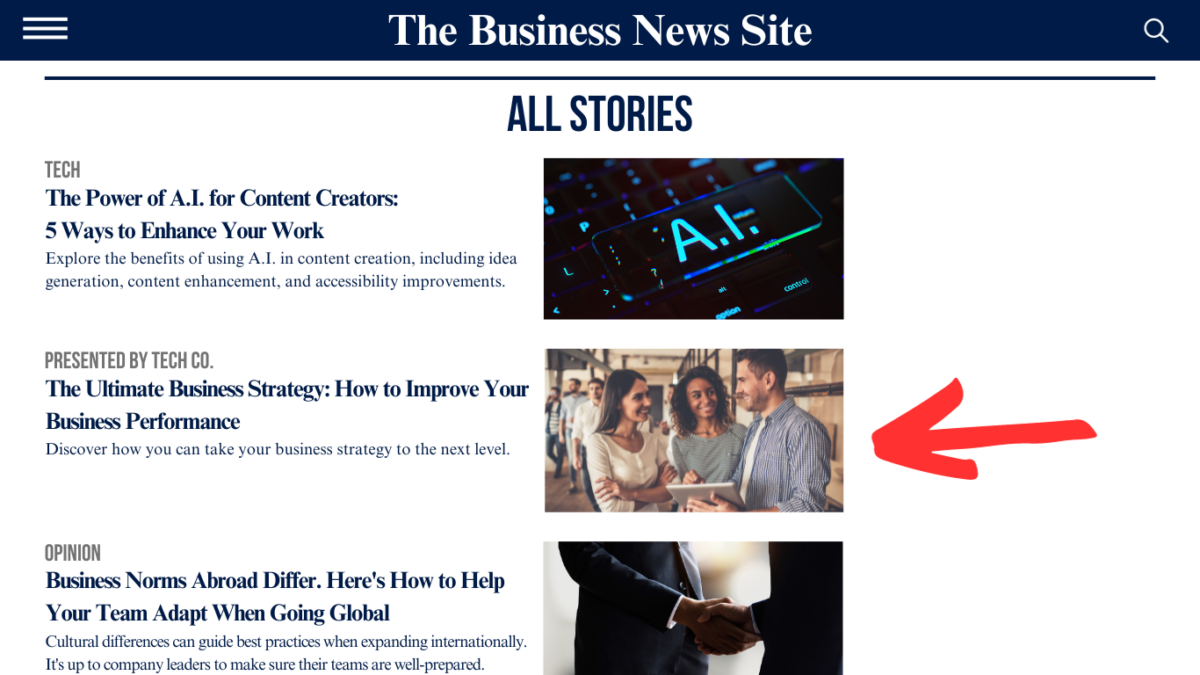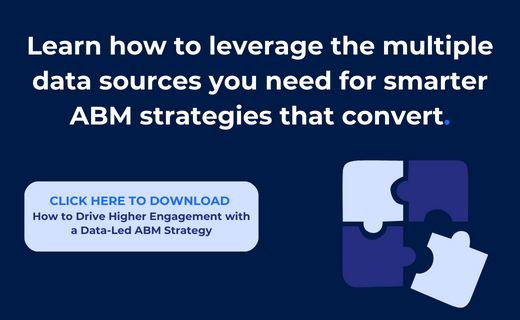
Using Digital Channels with Precision: Best Practices for Account-Based Display Advertising

Display advertising has a bad reputation, due to common misconceptions about its limited value in B2B campaigns. There’s even a myth that you’re more likely to survive a plane crash than click a banner ad.
The reality is this couldn’t be further from the truth.
In fact, research suggests that B2B display advertising is projected to surpass traditional search spending for the first time. When used as part of a comprehensive data-driven, multi-channel account-based marketing (ABM) strategy, display ads are critical in reinforcing key messaging and delivering content to target accounts. It’s also a proven method for generating higher clickthrough rates, web engagement, and pipeline.
In article four of our “Using Digital Channels with Precision” blog series, we dive into how to maximize display advertising in a unified, multi-channel ABM strategy, and the best practices to ensure your efforts drive the highest return on investment (ROI).
Display Advertising Formats and Types
Display advertising includes creative, visual ads to attract attention and spread brand awareness online. You can choose between standard display creative, such as banner ads, or a range of rich media alternatives when crafting their campaign strategies. Here, we’ve rounded up the most popular display ad formats for B2B marketing.
Standard display ads
Standard display ads are the most common type you see online. Also called banner ads, these typically consist of a static image with text and a call-to-action (CTA) directing buyers to another page.
Banner ads provide a visual and highly targeted way to deliver personalized messages and content to specific accounts. By tailoring the ad creative and messaging to meet each target account’s unique needs and pain points, you increase your chances of capturing the attention of key decision-makers within those accounts. Standard display ads also offer the benefit of reaching prospects across various online touch points, reinforcing brand awareness, and maintaining a consistent presence throughout the buyer’s journey.

Native display ads
Native ads fit naturally and seamlessly on a webpage, matching the site’s style and layout. Think of a sponsored post that appears in a newsfeed or on a platform. Native ads are typically seen on social media channels like LinkedIn or editorial publications, but you can use them anywhere you want your ad to blend in with other content.
The point of these ads is to have your content blend harmoniously with the other content it appears with, enhancing the user experience while subtly conveying your message. You can leverage native ads to deliver valuable and educational content, such as industry insights, thought leadership articles, or case studies, directly to decision-makers within their target accounts. By doing so, you’re positioning your brand as a trusted advisor, fostering credibility, and building relationships with key stakeholders. Additionally, native ads can be customized to align each target account’s specific interests and pain points, making them more compelling and relevant. The discreet nature of native ads also reduces ad blindness, ensuring that your message stands out amidst the noise.

Retargeting ads
Think of these as follow-up ads to target buying group members who visited your page, previously interacted with another ad, or took another action within a specified time frame.
These ads reinforce your brand’s presence and help nurture relationships with target accounts. By tracking the online behavior of decision-makers within these accounts, you can deliver highly relevant ads that align with their specific interests and engagement history. This personalized approach helps keep your brand top-of-mind as these prospects traverse the web, encouraging them to revisit your website, engage with your content, or take the desired action, such as signing up for a demo or purchasing your solution. Retargeting ads also allow you to extend the conversation and adapt your messaging based on how deeply the account has engaged with your brand previously. It’s a strategic way to maintain a consistent and persuasive touchpoint with potential clients, ultimately increasing the likelihood of conversion while optimizing your ad spend.

Best Practices for Account-Based Display Advertising
In our first article of this series, we discuss why multi-channel ABM helps you meet and influence buying committee members with a persistent, cohesive, and personalized experience. This comprehensive and unified data-driven approach accelerates the sales pipeline and helps convert your best accounts faster.
Following are best practices for account-based display advertising to make it a crucial part of your multi-channel strategy. Utilize multiple data sources to target the right accounts.
Use data to target the right accounts
Any ABM strategy requires you to speak directly to buyer needs. To personalize your messaging and shift away from generic ads you need a deep understanding of your target audience. Let data be your compass and use it to identify the accounts actively showing interest and the individuals within these accounts who are actively researching and engaging with pertinent content.
Tap into a combination of first-party and third-party data to pinpoint accounts with the highest likelihood of making a purchase. While your first-party data serves as a basis to determine target accounts, you also need access to historical performance, technographic, and intent data to create a clearer picture of the accounts demonstrating the highest propensity to purchase. Unify these data sources to prioritize the in-market accounts and identify key buyer personas.
Building comprehensive personas for buying committee members is critical for developing the personalized experiences buyers crave. Combining data sources and paying attention to specific attributes like job titles and departments helps you profile and map out who these buyers are.
Don’t limit your focus to just acquiring new accounts. While many marketers view it primarily as a tool for gaining new logos, insights from Forrester suggest a broader application. You can effectively employ digital advertising with existing customers, particularly when repositioning your brand within new buying centers or reaching fresh individual buyers. The key is to harness data-driven personalization to strategically target new and existing accounts, aligning your messaging with each audience segment’s unique needs and preferences.
Personalize creatives and messaging to buyer needs
Personalization is crucial in ABM to build a stronger relationship with buyers. You need to consistently craft dynamic ads tailored to the unique characteristics of your target accounts to keep them engaged. To do that, you need to leverage data insights to better understand your target buyers. This is another area where the use of multiple data sources helps paint a clearer picture of their needs and pain points. Using data to understand their challenges, roles, and values allows you to personalize the content and messaging they need based on where they are in the buying journey.
To make your B2B display ads truly stand out, they must be visually captivating. Aim to create ads that are clear, concise, engaging, and directly relevant to your audience’s interests. Never underestimate the power of a compelling call-to-action; it’s the driving force behind encouraging your audience to take a desired action.
Successful display ads often prioritize depth and focus on nurturing long-term relationships. The key is to authentically engage with your audience, offering valuable insights and solutions that resonate over time, fostering trust, and building lasting connections with your target accounts.
Leverage a unified approach to maximize display advertising’s utility and effect
To truly maximize the effectiveness of account-based digital display advertising, use it in a comprehensive multi-channel ABM strategy. This synergy across channels, including email, social, and more, is pivotal. It ensures that your messaging and branding remain consistent across all touch points, presenting a unified front to your target accounts. Focus on directing your efforts toward accounts with the highest likelihood of engagement and purchase. Targeting these accounts strategically increases your chances of success.
Resist the temptation to transform your digital display advertising campaign into a strict lead generation effort by gating assets on your website or landing page. Instead, prioritize the delivery of valuable, ungated content to build trust and engagement.
Consider display advertising as an initial step in your ABM journey, paving the way for deeper and broader engagement with your target accounts through subsequent efforts. By using display advertising as a starting point and then nurturing these accounts through other channels, you can foster more meaningful connections and ultimately drive better results in your account-based marketing strategy.
Monitor and optimize campaigns continually, not at the end
Harness the power of real-time data to drive ongoing enhancements in your messaging and targeting, resulting in increased reach and engagement. Continuous improvement is key to unlocking the full potential of your campaigns.
To refine your approach, routinely delve into the specifics of each account’s most effective channels, content preferences, and advertising receptiveness. A deeper understanding of what works and what doesn’t enables you to identify optimization opportunities more swiftly, tailoring your efforts to each account’s unique characteristics.
Keep a vigilant eye on engagement metrics, including impressions, open rates, site visits, and downloads. These metrics offer valuable insights into how your buyers are interacting with your ads and how effective your content is in guiding them through the buying journey, helping you fine-tune your strategies for maximum impact.
Moreover, don’t overlook performance data like pipeline volume, value, and velocity. These metrics provide marketers with a holistic view of how their campaigns influence the sales pipeline, offering essential insights into the overall effectiveness of your ABM efforts. By continuously monitoring and leveraging this data, you can make informed decisions to refine and enhance your account-based marketing strategy.
Test and learn, then test again
Running A/B tests is a must in display advertising. These tests allow you to pinpoint specific variables, such as creative assets, messaging, and landing pages, that can lead to incremental improvements in your campaigns.
It’s crucial to understand that even with your expertise, getting ads right on the first try is a rarity. Embrace the fact that experimentation is a fundamental part of the process. Be open to trying different messaging, CTAs, ad sizes, formats, and any other adjustable elements to find what resonates best with your audience.
By continuously experimenting and fine-tuning your approach based on data-driven insights, you’ll stay ahead of the curve and consistently improve the performance of your digital advertising efforts.
Start Driving Higher Brand Awareness with Display Advertising Today
When used in a data-driven, multi-channel ABM strategy, display ads are a powerful tool to connect with your target audience and drive conversions. Explore diverse display ad formats to craft engaging and personalized campaigns that effectively convey your brand’s message, ensuring your solution remains top of mind.
Nevertheless, bear in mind that successful display advertising hinges on a strategic approach rooted in data-driven insights. Take the time to understand your buyers, what motivates them, and who they are. This knowledge forms the foundation for creating personalized ads that resonate and engage effectively.
By integrating these best practices into your approach and including the various types of display ads in your ABM campaigns, you’re poised to construct a comprehensive, full-funnel ABM strategy that aligns with your marketing objectives and delivers tangible results.


